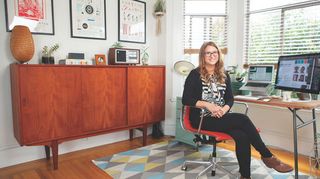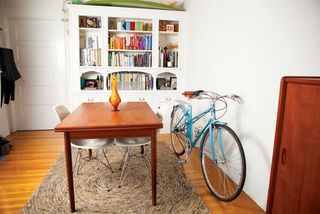Discover how classical design can inspire you
Creator of Style Tiles Samantha Warren reveals how past design philosophies can still have a big impact on the now.

If you didn't know anything about Samantha Warren and somehow found yourself in her home, it would quickly become apparent that she's a person with a strong sense of style.
"I like mid-century modern furniture," she tells us. It's a style that's fairly fashionable at the moment, having been popularised by Mad Men; have a look for Knoll, Ercol and Eames to get the idea. A prized possession is her Eames desk chair.
"While I am very much influenced by the work of Charles and Ray Eames, it's their design philosophy that has the most impact for me," says Warren. She explains that the Eames duo had a holistic vision of design – they viewed it as a life skill as opposed to a professional one. As well as furniture, they made films, toys, fashion and architecture, and the influences of one discipline bled into the others.

Warren sees a parallel in her approach to web design. "The web is one of many elements in the larger ecosystem. As a designer it is my responsibility to bring all those influences to the table when solving a problem that lives in the digital space."
She also admires the way the duo prioritised practicality – "their work wasn't just there to be looked at, it was for everyone to use" – and the fact that they designed for everyday contexts such as schools and airports, where design is often overlooked.
"I, too, enjoy the challenge of taking the everyday applications and trying to approach them holistically and in an interesting way. A support website, hotel checkout flow and a video conferencing app have been some of the most exciting designs I've tackled."
Losing track
Like Ray Eames, Warren has a background in painting, and she describes a "feeling of losing track of time and being completely inside of what you are making", when she paints and when working on web projects.

Design has always been a strong force in Warren's life, and her tastes were developed from an early age: her mother was a fashion illustrator and her father owned a printing company. "I always knew I wanted to be a designer," she says. She went to a traditional design school to learn print design, and while there she met a man who offered her a unique opportunity.
"He had hired developers before and taught them how to design, and he was interested in hiring a designer and teaching them how to develop websites. So he tried this experiment with me."
The job was with the US Army, which was not an area of interest, but it gave Warren the chance to learn HTML and CSS. Around 2007 she landed a job at Ogilvy designing for social media marketing, which proved to be a transformative experience.
"It changed my perspective and helped me to shape my values around how I wanted to communicate with the world and operate as a designer. I had many humbling moments where I realised that being a designer was not about working in a silo, it was about leveraging the resources and the brilliant minds around me to contribute to a more positive outcome."
Asked why she loves working on the web, Warren tells us that the web feels like the new frontier: "If you look at the history of graphic design, it spans hundreds of years of innovation. Web design is just a tiny dot at the end, and we've progressed so quickly because we're turning how we share information on its head."
She's also excited by the open culture found in the community. "Anyone can contribute, you can learn anything you want. There's so much opportunity. The web is open and inviting and that's what makes it such an interesting endeavour. I love the culture of the web community and the idea that sharing is a valued activity."
On the tiles
Warren is best known for creating Style Tiles, a system for developing the visual language for a website. A few years before, Warren designed a site for a Scandinavian hotel chain. She and the client agreed that the site should somehow capture the essence of the patio area outside one of the hotels, which was filled with transparent bubble chairs that reflected the landscape.

This idea of taking inspiration from other places and translating it into UI elements was a precursor to where Warren was going with Style Tiles, she explains. "These chairs looked how the client wanted the site to look, and they needed help getting from one to the other. So it was a matter of taking these attributes – the light, the almost invisible lines and this ethereal feeling – and dissecting and reconstructing them into things like gradients, thin lines and lots of very subtle shadows."
These pieces can then be used as the building blocks for UI elements. "You can use it to have a conversation around what someone is imagining in their head when they say certain things to describe a visual. You can say: 'You're saying the site should feel light and airy; so does this line feel light and airy, or does this one?' That's what Style Tiles is, it's the translation process."
A shifting industry
Until last September Warren was a senior designer at Twitter – an experience she describes as "electrifying", and "like being on a rocket ship" – and now she works for herself, based in San Francisco.
She chose to strike out on her own at a time when the web design industry is in a state of flux due to the building-up of big in-house design teams. Warren sees this as a natural evolution brought about by the shifting nature of the web.
"The industry is an ecosystem that's constantly changing. The same patterns repeat themselves time and again. I'm not sure this is anything new."
She explains that companies used to use the web as a marketing channel to find customers for their product, and this kind of website was perfect to hand off to an agency. But now often the product itself is web-based; the site is both the marketing channel and the thing being sold.
She cites online banking as an example. "This isn't something you can break off in a chunk and send to an agency. You need people constantly working on it and building a knowledge base of what's been done before."
This shift is part of what's driving big companies to recruit their own internal teams. That doesn't mean agencies are dying though, emphasises Warren. "I think agencies will begin to morph into very unique speciality boutiques. That outside perspective is still really necessary."
She continues: "I miss agency work because of the fast pace, but the types of projects I'm really interested in are becoming the projects you find more in-house because they require a lot of complexity, data, and a large knowledge base. The natural evolution for me was to work in-house or to augment teams in-house."
Old school
Warren's current work often involves augmenting teams at big companies and tech startups in San Francisco. Sometimes she joins the team on her own, other times she will select specialists to join her.
"I am what you would call an old-school creative director or art director. I'm a generalist. I'm not really big on buzzwords but 'full-stack product designer' seems to be a title that's sticking. I do a bit of everything, and when it comes to specialising, it's usually visual language work."
Asked if there are any key principles she's lived by in her career, she says she never wants to create something that puts a burden on someone else. "Take direct mail, for example. I come home and there's all this paper everywhere. Rather than it helping and making my life better, it's detracting from it, and killing trees as well. I don't want to create anything that has a negative impact. It's a balancing act, because I have to make money, but for the most part I've been able to stick to it."
In line with her passion for sharing, Warren is a regular on the speaking circuit. Her main talks are about what it's like to be a designer on a cultural level, as this is where she thinks the magic happens.
"It's easy to become focused on tools and process, but those who I've seen being really successful in the environments that the web is evolving into are those who have the skills to manage change, to manage themselves, and to set their own expectations in terms of what they're capable of."

The biggest inspirations for Warren are those people redefining the role of the designer. "Being a designer is about finding solutions and making them happen within constraints, not just the tactical level of designing something that's aesthetically pleasing or usable. If your work doesn't ship, it doesn't matter."
Tools and process are easy to learn, so Warren believes it's more important to teach human skills such as empathy.
"I'm seeing folks lose perspective around what it means to actually be a designer in an organisation, or with a client.
People skills and empathy are needed, as is the skill of finding ways to make things happen in difficult situations.
"Those skills are not necessarily associated with being a designer, but those who are very successful often have them. I'm interested in how we can teach these skills and nurture them as a community."
Words: Tanya Combrinck
Tanya Combrinck is a freelance journalist covering web design and digital creative. This article was originally published in issue 171 of net magazine.
Liked this? Read these!
- The web designer's guide to style tiles
- The best photo editors
- The designer's guide to working from home

Thank you for reading 5 articles this month* Join now for unlimited access
Enjoy your first month for just £1 / $1 / €1
*Read 5 free articles per month without a subscription

Join now for unlimited access
Try first month for just £1 / $1 / €1
Get the Creative Bloq Newsletter
Daily design news, reviews, how-tos and more, as picked by the editors.
The Creative Bloq team is made up of a group of design fans, and has changed and evolved since Creative Bloq began back in 2012. The current website team consists of eight full-time members of staff: Editor Georgia Coggan, Deputy Editor Rosie Hilder, Ecommerce Editor Beren Neale, Senior News Editor Daniel Piper, Editor, Digital Art and 3D Ian Dean, Tech Reviews Editor Erlingur Einarsson and Ecommerce Writer Beth Nicholls and Staff Writer Natalie Fear, as well as a roster of freelancers from around the world. The 3D World and ImagineFX magazine teams also pitch in, ensuring that content from 3D World and ImagineFX is represented on Creative Bloq.
